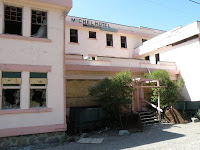Order "Jacob's Tails..." directly from the author
Check out the web site for the E-Book
http://www.firstepbooks.com/
We left
Our route was all mapped out – down Hwy 101 to Hwy 20, then across the hills to Hwy I-15 at Williams,
“Oh, don’t do that,” she told us, “that’s a terrible road across. Take 299 across to
We’re still not sure if she was confused, ON something, or thought it would be a good joke to play on these outsiders.
What a road! Not the four-lane she assured us of (it had the occasional third passing lane) – it twisted in and out and up and down through the Redwood trees; around the side of one mountain with a hairpin turn at the bottom that took us over to the next set of mountains only to wind up and down though the Redwoods over there and onto the next.
IF it hadn’t been so rainy AND if we hadn’t been in an RV AND if we had a sense of where we were going, I think it would have been a great trip BUT it was raining; we were in the RV AND we didn’t have clue where we were.
“Oh, I can make it in two and ½ hours in the car,” she told us. Well those two hours took us around five!
We finally came out at Highway I-5 near
Love the coast: don’t like the never-ending rain. Now we were out of the rains and in a completely different terrain. The hills (mountains, they call them) and fields were the muted colours of fall that held notice that winter was not far away. The road wondered along fields, orchards and vineyards and through rolling, rounded hills dotted with clusters of green trees and shrubs – mostly oak, I found out later.
At first I thought the mist was fog, but then realized that it wasn’t a mist, it was a haze generated by the smog sitting over the entire
Welcome to
The Oak Trees here are a lot different than the ones we saw in
My research into the Oak Trees of California actually describes them as Tree Oak and Shrub Oak. They site about nine different tree species, twelve different shrub species and various hybrid species.
They are incredibly prolific, given the right climate. One thing that distinguishes oak from other trees is that they produce acorns. The Natives used the acorns for food. They would make a kind of a mush and use it in breads and puddings and such. It is said to be very nutritional and is cited as being the foundation for a long healthy life.
Once we hit the Park of the Sierras (an Escapee Park just south of Yosemite National Park, about 30 miles north of
What a great place to take a break. Unlike most RV Parks that resemble parking lots with the occasional tree, POS (as they call it) is built on the side of a hill and the sites are scattered in and amongst the trees. The roads wind and climb throughout the whole area and each site is its own unique landscaped alcove.
We only spent a week or so in this part of
At the top of the hill we discovered a completely burnt-up motorhome on the side of the road. Now that was scary! It sure reminded us you how extra cautious you have to be. (It bothers me that there is no escape window in the bedroom and there should be!)
We did pull off a couple of times so I could get some pictures of the hundreds of wind mills that went on for miles along the ridge of the whole
Unlike our usual routine, we drove well into the night. Along the way, we stopped at Needles, CA for a bite to eat only to realize it was the same restaurant we stopped at with Ann & Eldon (a couple we travelled with) eight years ago.
The desert was calling and we arrived at the Avi Casino (right at the corner of
It’s funny how you can get so tired even though you aren’t actually driving.



















































